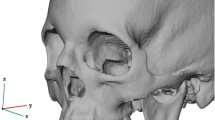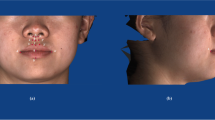Abstract
Introduction
Our knowledge of facial muscles is based primarily on atlases and cadaveric studies. This study describes a non-invasive in vivo method (3D MRI) for segmenting and reconstructing facial muscles in a three-dimensional fashion.
Methods
Three-dimensional (3D), T1-weighted, 3 Tesla, isotropic MRI was applied to a subject. One observer performed semi-automatic segmentation using the Editor module from the 3D Slicer software (Harvard Medical School, Boston, MA, USA), version 3.2.
Results
We were able to successfully outline and three-dimensionally reconstruct the following facial muscles: pars labialis orbicularis oris, m. levatro labii superioris alaeque nasi, m. levator labii superioris, m. zygomaticus major and minor, m. depressor anguli oris, m. depressor labii inferioris, m. mentalis, m. buccinator, and m. orbicularis oculi.
Conclusions
3D reconstruction of the lip muscles should be taken into consideration in order to improve the accuracy and individualization of existing 3D facial soft tissue models. More studies are needed to further develop efficient methods for segmentation in this field.
Similar content being viewed by others
References
Zhang Y, Prakash EC, Sunq E (2004) A new physical model with multilayer architecture for facial expression animation using dynamic adaptative mesh. IEEE Trans Vis Comput Graph 10: 339–352. doi:10.1109/TVCG.2004.1272733
De Greef S, Willems G (2005) Three-dimensional cranio-facial reconstruction in forensic identification: latest progress and new tendencies in the 21st century. J Forensic Sci 50: 12–17. doi:10.1520/JFS2004547
King SA, Parent RE (2005) Creating speech-synchronized animation. IEEE Trans Vis Comput Graph 11: 341–352. doi:10.1109/TVCG.2005.43
Chabanas M, Luboz V, Payan Y (2003) Patient specific finite element model of the face soft tissues for computer-assisted maxillofacial surgery. Med Image Anal 7: 131–151. doi:10.1016/S1361-8415(02)00108-1
Mollemans W, Schutyser F, Nadjmi N et al (2007) Predicting soft tissue deformations for a maxillofacial surgery planning system: from computational strategies to a complete clinical validation. Med Image Anal 11: 282–301
Xia J, Samman N, Yeung RW et al (2000) Computer-assisted three-dimensional surgical planning and simulation. 3D soft tissue planning and prediction. Int J Oral Maxillofac Surg 29: 250–254. doi:10.1016/S0901-5027(00)80023-5
Troulis Mj, Everett P, Seldin EB et al (2002) Development of a three-dimensional treatment planning system based on computed tomographic data. Int J Oral Maxillofac Surg 31: 349–357. doi:10.1054/ijom.2002.0278
Gering D, Nabavi A, Kikinis R et al (1999) An integrated visualization system for surgical planning and guidance using image fusion and interventional imaging. Int Conf Med Image Comput Comput Assist Interv 2: 809–819. doi:10.1007/10704282_88
Gering D (1999) A system for surgical planning and guidance using image fusion and interventional MR. MIT Master’s thesis
Nabavi A, Hata N, Gering D et al (1999) Image guided neurosurgery visualization of brain shift. In: Navigated Brain Surgery, pp 17–26
Pessa JE, Zadoo VP, Garza PA et al (1998) Double or bifid zygomaticus major muscle: anatomy, incidence, and clinical correlation. Clin Anat 11: 310–313. doi:10.1002/(SICI)1098-2353(1998)11:5<310::AID-CA3>3.0.CO;2-T
Teran J, Sifakis E, Blemker SS et al (2005) Creating and simulating skeletal muscle from the visible human data set. IEEE Trans Vis Comput Graph 11: 317–328. doi:10.1109/TVCG.2005.42
Pessa JE, Zadoo VP, Adrian EK Jr et al (1998) Variability of the midfacial muscles: analysis of 50 hemifacial cadaver dissections. Plast Reconstr Surg 102: 1888–1893. doi:10.1097/00006534-199811000-00013
Chuang DC, Wei FC, Noordhoff MS (1989) “Smile” reconstruction in facial paralysis. Ann Plast Surg 23: 56–65. doi:10.1097/00000637-198907000-00010
Waller BM, Cray JJ, Burrows AM (2008) Selection for universal facial emotion. Emotion 8: 435–439. doi:10.1037/1528-3542.8.3.435
Author information
Authors and Affiliations
Corresponding author
Electronic supplementary material
The Below is the Electronic Supplementary Material
Rights and permissions
About this article
Cite this article
Olszewski, R., Liu, Y., Duprez, T. et al. Three-dimensional appearance of the lips muscles with three-dimensional isotropic MRI: in vivo study. Int J CARS 4, 349–352 (2009). https://doi.org/10.1007/s11548-009-0352-8
Received:
Accepted:
Published:
Issue Date:
DOI: https://doi.org/10.1007/s11548-009-0352-8




